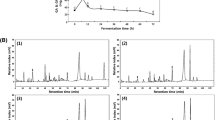Abstract
Cheonggukjang, a traditional soy food, was prepared with addition of Lentinus edodes powder at 0, 5, and 10% (w/w), and the distribution of isoflavones were analyzed by high performance liquid chromatography during fermentation for 48 h. β-Glucosidase activity and changes in succinyl genistin and succinyl daidzin were monitored. β-Glucosidase activity in cheonggukjang with 5 and 10% (w/w) L. edodes powder were significantly higher than those in control samples (p <0.05). Total isoflavones in 48-h fermented cheonggukjang with 0, 5, and 10% (w/w) L. edodes powder were 4.88, 4.26, and 3.99 μmole/g, respectively. Aglycones of isoflavones in cheonggukjang with 5 and 10% (w/w) L. edodes powder were 27.61 and 24.76% for 24 h and 28.2 and 38.74% for 48 h, whereas those in control samples were 5.50 and 21.11% for 24 and 48 h, respectively. Succinyl daidzin and succinyl genistin in L. edodes powder-added cheonggukjang were significantly lower than those of control samples (p <0.05), implying that β-glucosidase activity from L. edodes negatively affected the formation of succinyl derivatives.
Similar content being viewed by others
References
Choi EJ, Lee JS, Chang HB, Lee MS, Jang HD, and Kwon YI (2010) Changes in the functionality of Cheonggukjang during fermentation supplemented with Angelica gigas, Rehmanniae Radix, and Red ginseng. Korean J Microbiol Biotechnol 38, 467–474.
Choi HK, Lim YS, Kim YS, Park SY, Lee CH, Hwang KW, and Kwon DY (2008) Free-radical-scavenging and tyrosinase-inhibition activities of Cheonggukjang samples fermented for various times. Food Chem 106, 564–568.
Izumi T, Piskula MK, Osawa S, Obata A, Tobe K, Saito M, Kataoka S, Kubota Y, and Kikuchi M (2000) Soy isoflavone aglycones are absorbed faster and in higher amounts than their glucosides in humans. J Nutr 130, 1695–1699.
Joo EY and Park CS (2010) Antioxidative and fibrinolytic activity of extracts from soybean and chungkukjang (fermented soybeans) prepared from a black soybean cultivar. Korean J Food Preserv 17, 874–880.
Kim AR, Lee JJ, Lee H, Chang HC, and Lee MY (2010) Body-weight-loss and cholesterol-lowering effects of Cheonggukjang (a fermented soybean paste) given to rats fed a high-fat/high-cholesterol diet. Korean J Food Preserv 17, 688–697.
Larkin T, Price WE, and Astheimer L (2008) The key importance of soy isoflavone bioavailability to understanding health benefits. Crit Rev Food Sci Nutr 48, 538–552.
Lee JH, Renita M, Pioritto RJ, St. Martin SK, Schwartz SJ, and Vodovotz Y (2004) Isoflavone characterization and antioxidant activity of Ohio soybeans. J Agric Food Chem 52, 2647–2651.
Lee JO, Ha SD, Kim AJ, Yuh CS, Bang IS, and Park SH (2005) Industrial application and physiological functions of Chongkukjang. Food Sci Ind 38, 69–78.
Lee KA, Jang JO, Yoon HK, and Kim MS (2007) Antithrombotic activities of cheongkookjang and cheongkookjang fermented with green tea or mugwort. Korean J Microbiol 43, 298–303.
Lee SW and Lee JH (2009) Effects of oven-drying, roasting, and explosive puffing process on isoflavone distributions in soybeans. Food Chem 112, 316–320.
Park CU, Jeong MK, Park MH, Park MS, Kim MJ, Ahn SM, Chang PS, and Lee JH (2010) Formation of succinyl genistin and succinyl daidzin by Bacillus species. J Food Sci 75, C128–C133.
Park YW, Lee SW, Choi HK, Yang SO, Kim YS, Chun HN, Chang PS, and Lee JH (2009) Profiles of isoflavones and fatty acids in soymilk fermented with Lactobacilli, Bifidobacteria, or Streptococci. Food Sci Biotechnol 18, 294–298.
Pyo YH, Lee TC, and Lee YC (2005) Enrichment of bioactive isoflavones in soymilk fermented with β-glucosidase-producing lactic acid bacteria. Food Res Intl 38, 551–559.
Rhee CH, Lee JB, and Jang SM (2000) Changes of microorganisms, enzyme activity and physiological functionality in the traditional Deonjang with various concentrations of Lentinus edodes during fermentation. J Korean Soc Agric Chem Biotechnol 43, 277–284.
Rostagno MA, Villares A, Guillamón, E, García-Lafuente A, and Martínez JA (2009) Sample preparation for the analysis of isoflavones from soybeans and soy foods. J Chromatogr A 1216, 2–29.
Shimoni E (2004) Stability and shelf life of bioactive compounds during food processing and storage: Soy isoflavone. J Food Sci 69, R160–R166.
Shin HK (2006) Purification and characterization of β-glucosidase from pyogo mushroom, Lentinus deodes. MS Thesis, Seoul National University of Science and Technology, Seoul, Korea.
Shon MY, Kim MH, Park SK, Park JR, and Sung NJ (2002) Taste components and palatability of black bean Chungkugjang added with Kiwi and Radish. J Korean Soc Food Sci Nutr 31, 39–44.
Toda T, Uesugi T, Hirai K, Nukaya H, Tsuji K, and Ishida H (1999) New 6-Oacyl isoflavone glycosides from soybeans fermented with Bacillus subtilis (natto). I. 6-O-succinylated isoflavone glycosides and their preventive effects on bone loss in ovariectomized rats fed a calciumdeficient diet. Biol Pharm Bull 22, 1193–1201.
Uzzan M and Labuza TP (2004) Critical issues in R&D of soy isoflavone enriched foods and dietary supplements. J Food Sci 69, CRH77–CRH86.
Watanabe A, Yamaguchi S, Urabe K, and Asada Y (2003) Occurrence of a unique amino acid racemase in a basidiomycetous mushroom, Lentinus edodes. J Mol Cat B: Enzym 23, 379–387.
Yang SO, Chang PS, and Lee JH (2006) Isoflavone distribution and β-glucosidase activity in Cheonggukjang, a traditional Korean whole soybean-fermented food. Food Sci Biotechnol 15, 96–101.
Yang SO, Lee SW, Park YW, Lee SJ, Chang PS, Choi SS, and Lee JH (2008) Succinyl daidzin and succinyl genistin are new isoflavone derivatives found in Cheonggukjang. Food Sci Biotechnol 17, 172–175.
Zhang YZ, Lee JH, Vodovotz Y, and Schwartz SJ (2004) Changes in distribution of isoflavones and β-glucosidase activity during soy bread proofing and baking. Cereal Chem 81, 741–745.
Zheng ZX and Shetty K (2000) Solid state production of polygalacturonase by Lentinus edodes using fruit processing wastes. Process Biochem 35, 825–830.
Author information
Authors and Affiliations
Corresponding author
Rights and permissions
About this article
Cite this article
Park, J., Park, M.H., Jeong, M.K. et al. Changes of isoflavone profiles in Cheonggukjang with Lentinus edodes . J Korean Soc Appl Biol Chem 55, 115–119 (2012). https://doi.org/10.1007/s13765-012-0020-5
Received:
Accepted:
Published:
Issue Date:
DOI: https://doi.org/10.1007/s13765-012-0020-5




